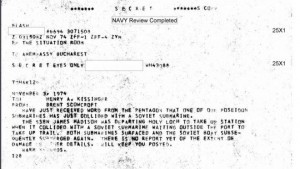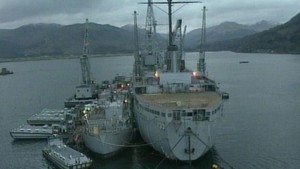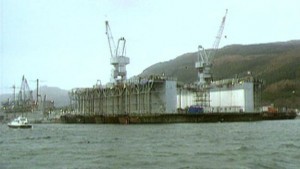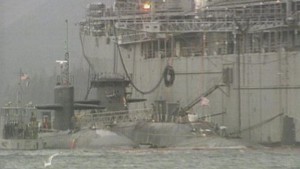A CIA document has revealed that two nuclear submarines collided in a sea loch just off the west coast of Scotland more than 40 years ago.
The top secret memo, which has just been declassified, tells how a US submarine collided with a Russian vessel near Holy Loch in November 1974.
The cable marked “Secret eyes only” was sent to US secretary of state Henry Kissinger.
The memo says there were no reports of the extent of the damage.
It is understood the US submarine was taken back to its base with significant damage to its hull.
The US maintained a Cold War nuclear submarine base at Holy Loch, in Argyll, between 1961 and 1992.
A second cable tells how the Washington Post had run a story on the collision between the US Polaris submarine and the Russian attack vessel two months later in January 1975.

However, the US military never confirmed the incident.
The secret document was among 13 million pages of declassified documents from the US Central Intelligence Agency (CIA) to have been released online.
The move came after lengthy efforts from freedom of information advocates and a lawsuit against the CIA.
The memo send to Dr Kissinger by Brent Scowcroft, a national security adviser to President Ford said: “Have just received word from the Pentagon that one of our Poseidon submarines has just collided with a Soviet submarine.
“The SSBN James Madison was departing Holy Loch to take up station when it collided with a Soviet submarine waiting outside the port to take up trail.
“Both submarines surfaced and the Soviet boat subsequently submerged again. There is no report yet of the extent of the damage. Will keep you posted.”
Defence system
The SSBN James Madison was commissioned in 1964 and modified in the early 1970s to carry the Polaris missiles.
These missiles were replaced by Trident in the late 1970s and early 1980s.
The James Madison was eventually decommissioned in 1992.
Dr Eric Graham, a marine historian from Edinburgh University, told BBC Scotland it could have been a diplomatic incident but because it was so deep into the UK/US home water it was an “embarrassment” that they wanted to keep quiet.
“It shows how easily they penetrated our defence system and threatened the biggest toy in our arsenal,” says Dr Graham.

The historian said that, during the Cold War, the Americans needed the Holy Loch base because Polaris only had a range of 2,500 miles and would not reach the Soviet Union from the US. They used the base to refit submarines to avoid returning to the US.
He said the nuclear submarines could “disappear” in the deep Atlantic but they had a problem when coming out of the narrow confines of the Holy Loch and travelling through the channel between north Antrim and the Kintyre peninsula.
Dr Graham said: “The big shock with this Victor class submarine was that it was off Arran.
“It would not happen today.
“It is trying to shadow an American Polaris-carrying submarine coming out of the loch. Once it locks onto it, it can follow it out into its patrol zone.
“If you have a hunter/killer sub behind every American Polaris-carrying sub, then you’ve got a game-changer.
“You can actually have a first strike and take out America’s first line of defence.”

SNP defence spokesman Brendan O’Hara said the reports of the 1974 nuclear submarine collision were “deeply worrying” and clearly a “lucky escape”.
The MP compared the secrecy over the crash to the recent disclosure that a Trident missile veered off course during a test in June last year – weeks before the Commons voted to spend £40bn renewing the nuclear weapons system.
Questioned by the BBC’s Andrew Marr on Sunday, Prime Minister Theresa May refused to say four times if she had known about the test ahead of the vote.
Mr O’Hara said: ”The truth is – as we saw with the Trident malfunction revelations – nothing has changed, it could happen again.
”We keep asking the UK government to realise how dangerous – how unsafe – how unreliable these weapons of mass destruction are.”
Ask me anything
Explore related questions





